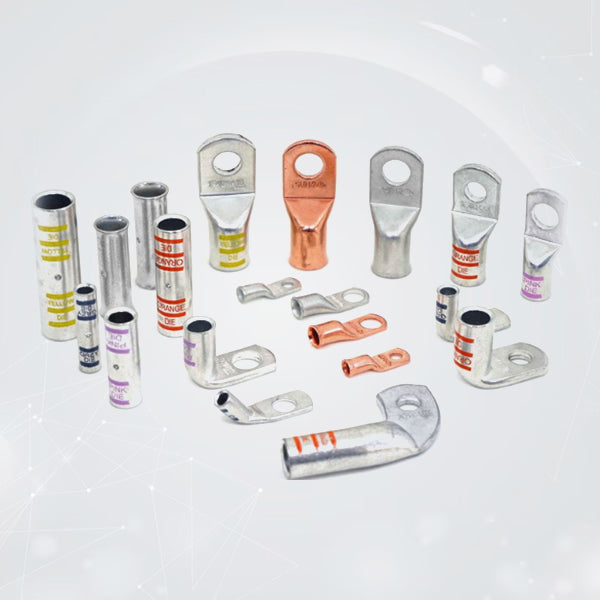
The Importance of Tinned Copper Lugs in Reliable Battery Connections
Whether you're working on an automotive electrical system, installing a solar battery bank, or maintaining a marine power setup, one thing is certain: reliable battery connections are non-negotiable. They serve as the lifeline for uninterrupted power flow, system safety, and long-term performance. A small failure at a battery terminal can lead to inefficient power transfer, frequent maintenance, or even hazardous conditions.
That's where tinned copper lugs come into play. Often overlooked, these small but essential components provide not only a secure mechanical connection but also superior electrical conductivity and corrosion resistance. In this guide, we dive into why tinned copper lugs are essential for battery connections, how they work, and best practices for getting the most out of them.
What Are Tinned Copper Lugs?
Tinned copper lugs are a type of electrical connector made from high-purity copper and coated with a layer of tin plating. Copper, by itself, is an excellent conductor of electricity and is widely used in wiring due to its low electrical resistance and malleability.
However, copper also has one downside — it's prone to oxidation when exposed to moisture or air, which can degrade its conductivity over time. To combat this, a thin layer of tin (typically 3–6 microns thick) is applied to the surface of the copper lug. This tin coating forms a barrier that resists oxidation and chemical corrosion, significantly enhancing the lug’s performance and lifespan.
In essence, tinned copper lugs combine the conductivity of copper with the durability of tin, making them ideal for demanding environments.
Why Tinned Copper Lugs Are Essential for Battery Connections
Battery terminals are high-contact points in any electrical system. They endure current surges, environmental stress, and repeated mechanical vibrations. The integrity of these connections directly influences system efficiency and safety. Here’s why tinned copper wire lugs stand out:
1. Enhanced Durability in Harsh Environments
Battery setups — especially in marine, automotive, RV, or solar systems — are often exposed to water, humidity, salt, chemicals, and wide temperature ranges. Under such conditions, regular copper lugs can corrode quickly, compromising the connection.
Tinned copper lugs offer an added layer of defense. The tin plating prevents oxidation, meaning the copper underneath stays clean and conductive for much longer. This is particularly valuable in marine environments, where saltwater exposure can rapidly corrode untreated copper connectors.
2. Stable and Low-Resistance Electrical Connections
Corrosion doesn’t just weaken the physical structure of a connector — it also increases electrical resistance, which can lead to voltage drops, poor battery performance, and potential overheating.
Tinned copper lugs minimize resistance over time by staying free of rust and oxidation, ensuring stable, efficient power flow. This consistent performance is vital in systems that require dependable current delivery, such as deep-cycle battery banks or backup power supplies.
3. Extended Service Life and Lower Maintenance
One of the most overlooked benefits of tinned copper lugs is their contribution to long-term system reliability. By resisting corrosion and maintaining conductivity, they reduce the frequency of replacements and maintenance checks.
This is especially important in remote or critical installations — such as solar energy systems or emergency power units — where downtime can be inconvenient or costly. Once installed properly, tinned lugs provide peace of mind that the connection will hold up over time.
4. Versatile Applications Across Power Systems
Tinned copper lugs are used across a wide variety of battery-powered systems, including:
- Battery banks in off-grid solar and wind power systems
- Marine battery connections in boats and yachts
- Automotive and truck battery terminals
- RV and camper power systems
- Backup and UPS power solutions
Their robust nature makes them adaptable to almost any high-current application, especially where longevity and resistance to environmental wear are priorities.
Best Practices for Installation
Even the most durable lug won’t perform optimally if it’s not installed correctly. Follow these guidelines to ensure a secure, long-lasting connection:
1. Proper Cable Preparation
Before attaching the lug, strip the insulation from the cable to expose the correct length of conductor. Make sure the wire strands are clean, free of corrosion or debris, and not frayed. A clean contact surface is key to effective crimping and conductivity.
2. Choosing the Right Lug Size
Always use a lug that matches your wire gauge. An undersized lug won’t fit, and an oversized one may create a loose, unreliable connection. Refer to product specifications to find a lug suited for your cable size and terminal post.
3. Correct Crimping Techniques
Use a professional-grade crimping tool designed for the specific lug and cable size. The crimp should compress the conductor tightly enough to be gas-tight but should not damage or puncture the tin coating.
Avoid hammer crimps or makeshift tools that may distort the lug and reduce contact surface area. A properly crimped lug should not shift or rotate on the wire.
4. Post-Crimp Inspection
After crimping, inspect the connection visually. There should be no exposed wire strands, and the crimp should appear uniform and secure. A simple pull test can confirm the mechanical integrity of the crimp.
5. Environmental Protection
For added protection — especially in corrosive or wet environments — apply heat shrink tubing over the crimped connection. You can also use a sealant or corrosion inhibitor to further prolong the life of the joint.
Maintenance Tips for Long-Term Reliability
Even with the best components, periodic inspection ensures continued safety and performance. Here are a few maintenance pointers:
- Inspect regularly for signs of discoloration, oxidation, or mechanical loosening.
- Clean minor corrosion with a wire brush or emery cloth; apply a corrosion-resistant compound if needed.
- Tighten any loose connections, especially in systems that experience vibrations (vehicles, boats, etc.).
Technical Details Recap
- Tin Coating Thickness: Typically 3–6 microns
- Operating Temperature Range: -40°C to 177°C
- Compatible Applications: Automotive, marine, solar battery banks, RVs, backup systems
- Material: High-conductivity copper with tin plating
Conclusion
When it comes to battery connectivity, the small details matter — and tinned copper cable lugs are one of the most critical yet overlooked details in a well-functioning electrical system. Their ability to resist corrosion, deliver consistent conductivity, and endure harsh conditions makes them an indispensable choice for reliable power connections.
Whether you're outfitting a boat, setting up a solar energy storage system, or maintaining vehicle batteries, using tinned copper battery lugs ensures that your connections are strong, safe, and built to last. With proper installation and care, they’ll serve your system faithfully for years to come.

